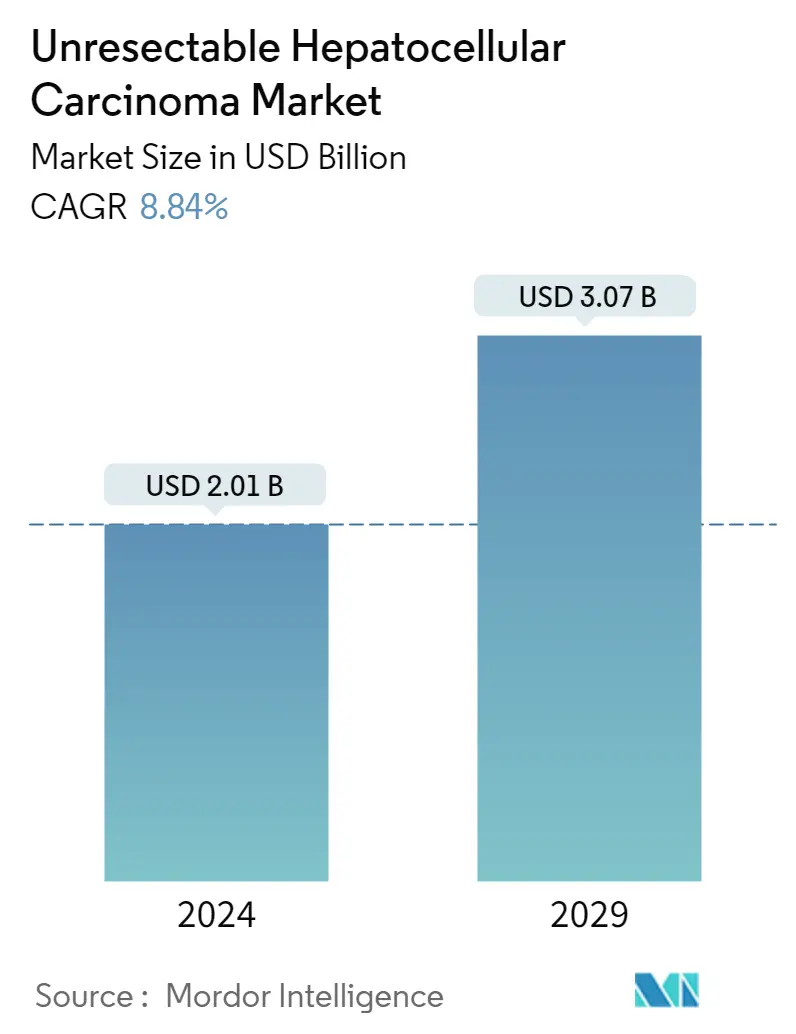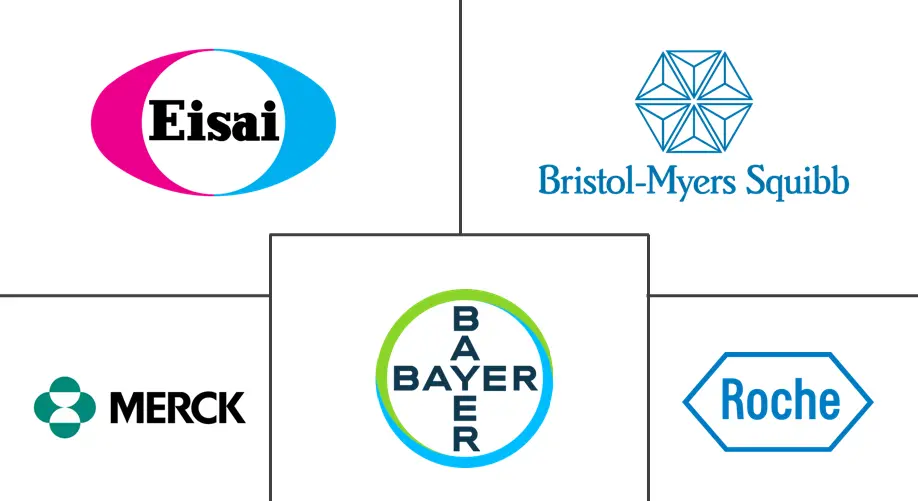Market Size of Unresectable Hepatocellular Carcinoma Industry

| Study Period | 2019 - 2029 |
| Market Size (2024) | USD 2.01 Billion |
| Market Size (2029) | USD 3.07 Billion |
| CAGR (2024 - 2029) | 8.84 % |
| Fastest Growing Market | Asia Pacific |
| Largest Market | North America |
Major Players
*Disclaimer: Major Players sorted in no particular order |
Unresectable Hepatocellular Carcinoma Market Analysis
The Unresectable Hepatocellular Carcinoma Market size is estimated at USD 2.01 billion in 2024, and is expected to reach USD 3.07 billion by 2029, growing at a CAGR of 8.84% during the forecast period (2024-2029).
The COVID-19 pandemic has significantly impacted the unresectable hepatocellular carcinoma market. As per a research study titled "Impacts of COVID-19 on Liver Cancers: During and after the Pandemic", published in the National Library of Medicine in May 2020, hepatocellular carcinoma (HCC) patients are more vulnerable to the effects of COVID-19 than other cancer patients as the hepatic injury caused by SARS-CoV-2 could complicate the existing hepatitis virus infection and cirrhosis. Further, barriers to accessing cancer drugs during the COVID-19 pandemic endangered the stability and integrity of pharmaceutical supply chains, thus limiting the supply of drugs across healthcare facilities. Thus, the COVID-19 pandemic has altered healthcare priorities, which may adversely impact HCC management.
The major factors fueling the market's growth are the high incidence rate of liver carcinoma and the advancement in new treatment options.
The high incidence rate of liver carcinoma is a major factor driving the market's growth. According to a September 2021 update by the Centers for Disease Control and Prevention, each year, about 24,500 men and 10,000 women in the United States get liver cancer, and about 18,600 men and 9,000 women die from the disease. As per the statistics, there is a significant rise in the patient pool, which is expected to boost the market's growth. Additionally, according to GLOBOCAN 2020, the estimated number of new liver cancer cases worldwide in 2020 was 906,000, and the number is expected to reach 1.40 million by 2040. Thus, the increasing incidence rate of liver cancer reflects the growing rate of unresectable hepatocellular carcinoma, which is augmenting the demand for unresectable HCC treatment.
Moreover, advancements in new treatment options are boosting the market's growth. For instance, according to an article published in Karger Journal, in 2021, various phase 3 trials reported a clinical benefit for the tyrosine kinase inhibitors lenvatinib, regorafenib, and cabozantinib in HCC. Additionally, as per a 2022 update by The Reagents of the University of California, 51 clinical trials are in progress for hepatocellular carcinoma treatment. As per an October 2021 published article titled "Hepatic Arterial Infusion Chemotherapy Is a Feasible Treatment Option for Hepatocellular Carcinoma: A New Update", hepatic arterial infusion chemotherapy (HAIC) has greater survival in patients with advanced HCC. Thus, the availability of advanced drugs in the treatment of hepatocellular carcinoma is expected to boost the market over the forecast period.
However, fewer diagnoses and poor efficacy of current therapeutic agents are major factors restraining the market's growth.
Unresectable Hepatocellular Carcinoma Industry Segmentation
As per the scope of the report, unresectable hepatocellular carcinoma is defined as a type of liver tumor not eligible for resection therapy given the extent of the disease, including patients that were not suitable for surgery for the location of the tumor(s) in the liver, those who were older than 75 years, or those who refused surgical therapies. The market is segmented by treatment, end user, and geography. The market report also covers the estimated market sizes and trends for 17 countries across major regions globally. The report offers the value in USD million for the above segments.
| By Treatment | |
| Chemotherapy | |
| Molecularly Targeted Therapy | |
| Immunotherapy | |
| Other Treatments |
| By End User | |
| Hospitals | |
| Cancer Centers | |
| Other End Users |
| By Geography | ||||||||
| ||||||||
| ||||||||
| ||||||||
| ||||||||
|
Unresectable Hepatocellular Carcinoma Market Size Summary
The unresectable hepatocellular carcinoma market is poised for significant growth, driven by the high incidence rate of liver carcinoma and advancements in treatment options. The market has been impacted by the COVID-19 pandemic, which highlighted the vulnerability of HCC patients and disrupted pharmaceutical supply chains, affecting drug availability. Despite these challenges, the increasing prevalence of liver cancer globally is expected to boost demand for unresectable HCC treatments. The development of new therapies, including tyrosine kinase inhibitors and hepatic arterial infusion chemotherapy, is further propelling market expansion. However, the market faces challenges such as fewer diagnoses and the limited efficacy of current therapeutic agents, which could restrain growth.
In North America, particularly the United States, the market is expected to grow due to the rising prevalence of liver cancer, technological advancements in drug development, and increased research and development investments. Strategic initiatives by key market players, such as the granting of Orphan Drug Designation by the FDA to various treatments, are contributing to market growth. The competitive landscape is characterized by the presence of major companies like AstraZeneca, Bayer, and Bristol-Myers Squibb, which hold substantial market shares. These factors collectively indicate a promising growth trajectory for the unresectable hepatocellular carcinoma market over the forecast period.
Unresectable Hepatocellular Carcinoma Market Size - Table of Contents
-
1. MARKET DYNAMICS
-
1.1 Market Overview
-
1.2 Market Drivers
-
1.2.1 High Incidence Rate of Liver Carcinoma
-
1.2.2 Advancement in New Treatment Options
-
-
1.3 Market Restraints
-
1.3.1 Less Diagnosis and Poor Efficacy of Current Therapeutic Agents
-
-
1.4 Porter's Five Forces Analysis
-
1.4.1 Threat of New Entrants
-
1.4.2 Bargaining Power of Buyers/Consumers
-
1.4.3 Bargaining Power of Suppliers
-
1.4.4 Threat of Substitute Products
-
1.4.5 Intensity of Competitive Rivalry
-
-
-
2. MARKET SEGMENTATION (Market Size by Value - USD million)
-
2.1 By Treatment
-
2.1.1 Chemotherapy
-
2.1.2 Molecularly Targeted Therapy
-
2.1.3 Immunotherapy
-
2.1.4 Other Treatments
-
-
2.2 By End User
-
2.2.1 Hospitals
-
2.2.2 Cancer Centers
-
2.2.3 Other End Users
-
-
2.3 By Geography
-
2.3.1 North America
-
2.3.1.1 United States
-
2.3.1.2 Canada
-
2.3.1.3 Mexico
-
-
2.3.2 Europe
-
2.3.2.1 Germany
-
2.3.2.2 United Kingdom
-
2.3.2.3 France
-
2.3.2.4 Italy
-
2.3.2.5 Spain
-
2.3.2.6 Rest of Europe
-
-
2.3.3 Asia-Pacific
-
2.3.3.1 China
-
2.3.3.2 Japan
-
2.3.3.3 India
-
2.3.3.4 Australia
-
2.3.3.5 South Korea
-
2.3.3.6 Rest of Asia-Pacific
-
-
2.3.4 Middle-East and Africa
-
2.3.4.1 GCC
-
2.3.4.2 South Africa
-
2.3.4.3 Rest of Middle-East and Africa
-
-
2.3.5 South America
-
2.3.5.1 Brazil
-
2.3.5.2 Argentina
-
2.3.5.3 Rest of South America
-
-
-
Unresectable Hepatocellular Carcinoma Market Size FAQs
How big is the Unresectable Hepatocellular Carcinoma Market?
The Unresectable Hepatocellular Carcinoma Market size is expected to reach USD 2.01 billion in 2024 and grow at a CAGR of 8.84% to reach USD 3.07 billion by 2029.
What is the current Unresectable Hepatocellular Carcinoma Market size?
In 2024, the Unresectable Hepatocellular Carcinoma Market size is expected to reach USD 2.01 billion.

